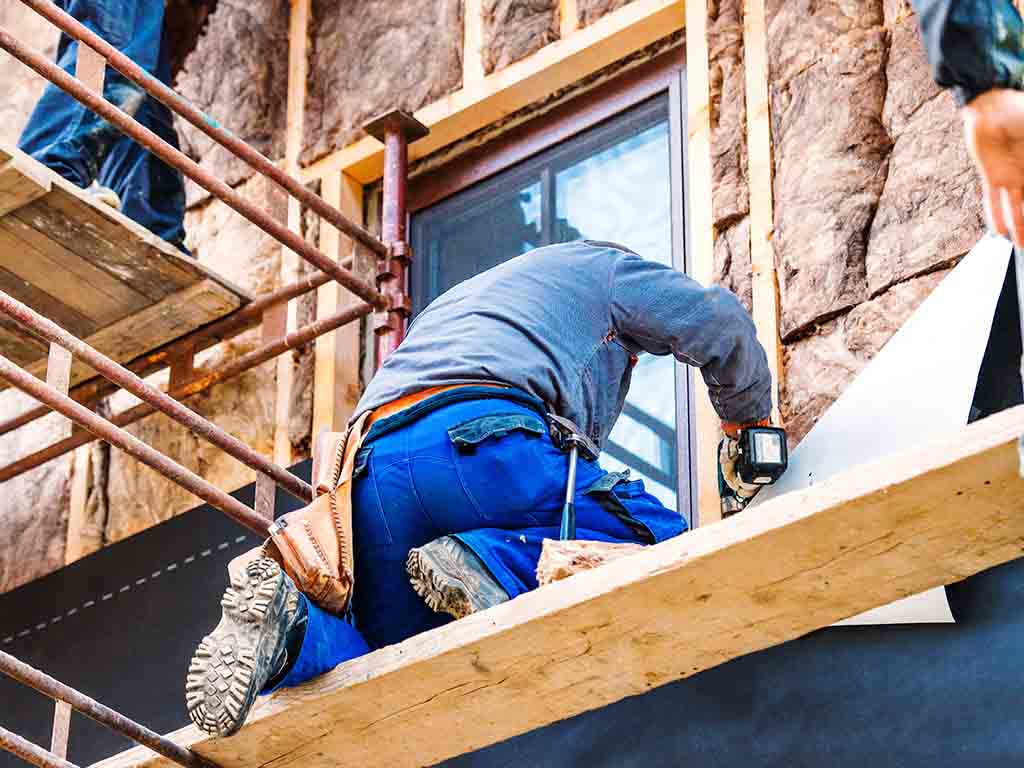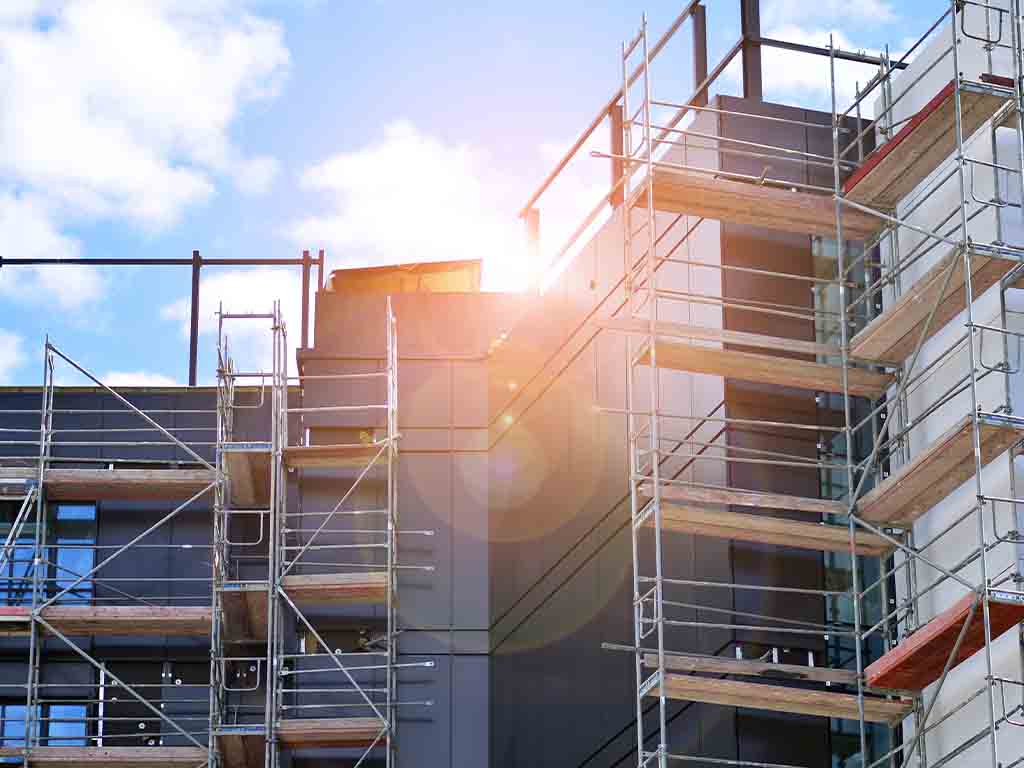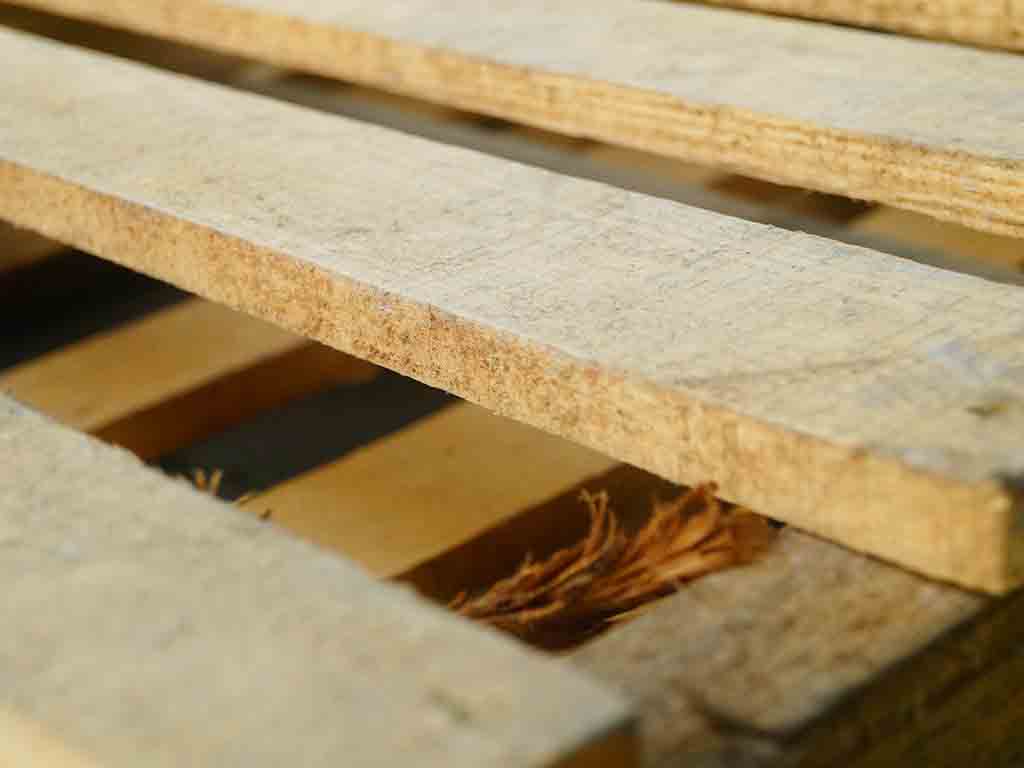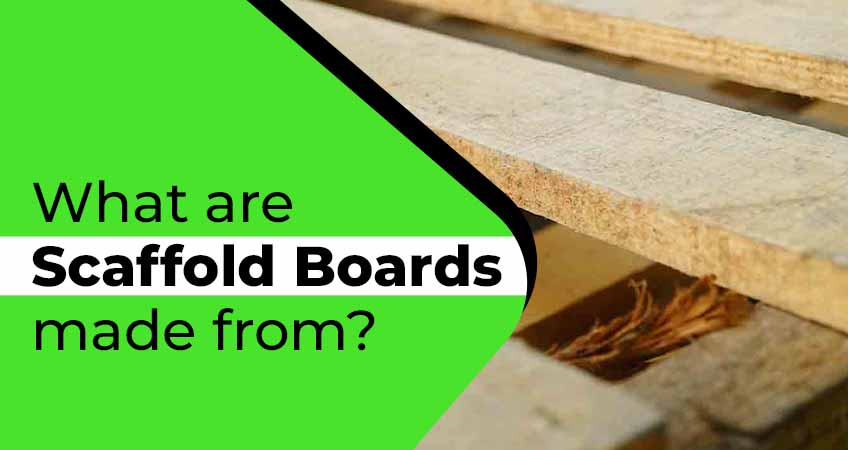Scaffold boards (more specifically the scaffolding structure as a whole) are essential in the construction and renovation industries. They create platforms for workers allowing them to safely work at height.
This blog will explore the materials used to make scaffold boards, additional scaffold components, how to maintain and inspect them for safety, and why hiring a professional scaffolding company, like B-Mat Scaffolding, is a worthwhile investment.
So no matter if you’re a construction professional, a DIY enthusiast planning a home renovation or perhaps just a curious gardener who uses scaffold boards as makeshift fencing for their flower beds, you’ll find all of your scaffold board questions answered here.
So let’s begin!
What are scaffold boards made from?

The primary material for scaffold boards varies depending on geographical location and safety regulations. The materials used are chosen with durability, strength, and versatility in mind to ensure they can withstand the rigours of construction work.
European whitewood in the UK
For UK scaffold boards, responsibly-sourced European whitewood—a type of softwood that is highly durable, sturdy, and versatile—is the British standard. This wood is ideal because of its natural structure, which ensures enhanced stability and the ability to carry heavy loads, such as tools and multiple workers.
European whitewood is also preferred because it grows into long and thick trees, providing boards that are longer and stronger. This durability minimises the risk of accidents on-site, keeping workers safe and ensuring regulatory compliance.
Materials used worldwide
Outside the UK, other types of wood are commonly used for scaffold boards depending on local availability and conditions:
- Douglas fir: Valued for its strength and resistance to wear, this is often used in North America.
- Southern yellow pine: A denser and highly durable wood that provides exceptional load-bearing capabilities, often used in the USA.
- Bamboo: Popular in parts of Asia, bamboo is a sustainable alternative that offers high tensile strength and flexibility.
Other scaffolding components

Aside from scaffold boards, scaffolding consists of other essential materials to form the structure:
- Aluminium: Lightweight and easy to assemble, aluminium poles are commonly used for flexibility in construction projects that require regular adjustments.
- Steel: Known for its strength and durability, steel is ideal for heavy-duty projects and environments with harsh weather conditions.
- Fibreglass: A newer material in scaffolding, fibreglass is non-conductive and ideal for projects near electrical lines, ensuring worker safety.
- Fasteners and fittings: Metal components like hoop irons or nail plates are used to secure scaffold boards for added stability.
By combining durable scaffold boards with strong scaffold poles, the result is a platform that ensures both safety and efficiency.
Maintenance and safety checks for scaffold boards

Regular maintenance and safety inspections of scaffold boards are essential to ensure longevity and avoid on-site accidents. Here are some critical steps to follow:
Visual inspection
Inspect scaffolding boards for any visible damage, such as warping, splits, or cracks. Pay special attention to the edges and ends, as these areas are most prone to wear and tear from exposure to the elements.
Check for signs of rot
Rot can weaken wooden boards, and this can be identified by discoloured or soft patches. Check the boards using slight pressure to ensure they maintain their firmness.
Inspect metal components
For boards that connect to metal scaffolding, examine components like screws, bolts, and plates for rust or loosening. Corroded or loose fittings can compromise structural integrity.
Test structural strength
Apply weight or pressure to the boards to ensure they maintain stability without bending excessively. Boards that fail this test should be replaced immediately.
General maintenance tips
- Storage: Store boards in a dry, ventilated area to protect against rot and warping.
- Cleaning: Remove dirt and debris after each use with a mild wood cleaner.
- Protective coatings: Apply weatherproof seals to maximise longevity.
- Handling care: Avoid dragging boards or exposing them to unnecessary stress during transport.
Taking proper care of your scaffold boards ensures their durability and safety for long-term use.
Why you should hire a scaffolding company

Ensuring the safety of your scaffolding is not something to leave to chance, particularly for construction and renovation projects.
That’s where hiring a professional scaffolding company can make all the difference. Here are just a few benefits:
Expertise and experience
Professional scaffolding companies employ highly trained teams with deep knowledge of scaffold board materials, structural stability, and safety compliance.
Safety and regulation compliance
Using a certified scaffolding company guarantees that all materials meet industry standards and local regulations. Companies will perform necessary safety checks and ensure your scaffolding is built correctly.
Time and cost savings
By outsourcing the scaffolding component of your project, you save time that would otherwise be spent on planning and assembly. Additionally, a professional setup reduces the likelihood of costly accidents or repairs. Check our blog, to understand more about scaffolding cost.
Why choose B-Mat Scaffolding?
If you’re looking for a scaffolding provider that combines expertise, safety, and high-quality materials, look no further than B Mat Scaffolding.
High-quality materials
At B Mat Scaffolding, we use only premium materials, including European whitewood boards, high-grade steel poles, and secure fittings. Safety is at the core of everything we do.
Experienced professionals
Our qualified and accredited team has years of experience serving construction professionals and home renovators alike. We ensure every scaffold meets safety regulations and is tailored to your project’s specific requirements.
Positively reviewed by our customers
B Mat Scaffolding has built a reputation for excellence and trust among our clients. We pride ourselves on offering reliable, safe scaffolding solutions with top-tier customer service.
Fast delivery and setup
With B Mat Scaffolding, you can expect efficient delivery and assembly of your scaffolding, minimising delays and keeping your project on track. We’ll be able to give you a delivery date and setup time when you initially call and in some cases are able to offer next day delivery.
Get your free quote today!
Don’t leave your project’s safety to chance. Get in touch with B Mat Scaffolding to receive a free quote and learn more about how our scaffolding solutions can help your next project succeed.
Contact us today for expertise you can rely on.
FAQ
Can scaffold boards warp?
Yes, scaffold boards are susceptible to warping and other forms of wear and tear due to exposure to the elements. Proper storage and maintenance can help prevent this.
What certifications should a professional scaffolding company have?
Look for companies with certifications from reputable organisations such as the National Access & Scaffolding Confederation (NASC) or the Construction Industry Scaffolders Record Scheme (CISRS). These demonstrate a commitment to safety and compliance in the industry.
Are all scaffold boards a standard width, length and thickness?
No, scaffold boards can vary in dimensions depending on their intended use and location. It’s essential to choose the right size for your specific project to ensure structural integrity and safety.
If you’re unsure, seek advice from a professional scaffolding company.
Why do some companies use timber scaffold boards?
Some companies prefer to use timber scaffold boards because they are cost-effective and readily available. Additionally, timber boards can also provide a more traditional aesthetic for certain projects. They sometimes also come with end bands that provide added stability and stop the timber from splitting.
Alternatively, some companies may choose to use alternative materials like aluminium or fibreglass for their scaffolding needs. Ultimately, the decision should be based on the specific requirements and regulations of the project at hand. It is always recommended to consult with a professional scaffolding company to determine the best option for your construction or renovation project. So there is no one-size-fits-all answer when it comes to choosing scaffold board materials.


